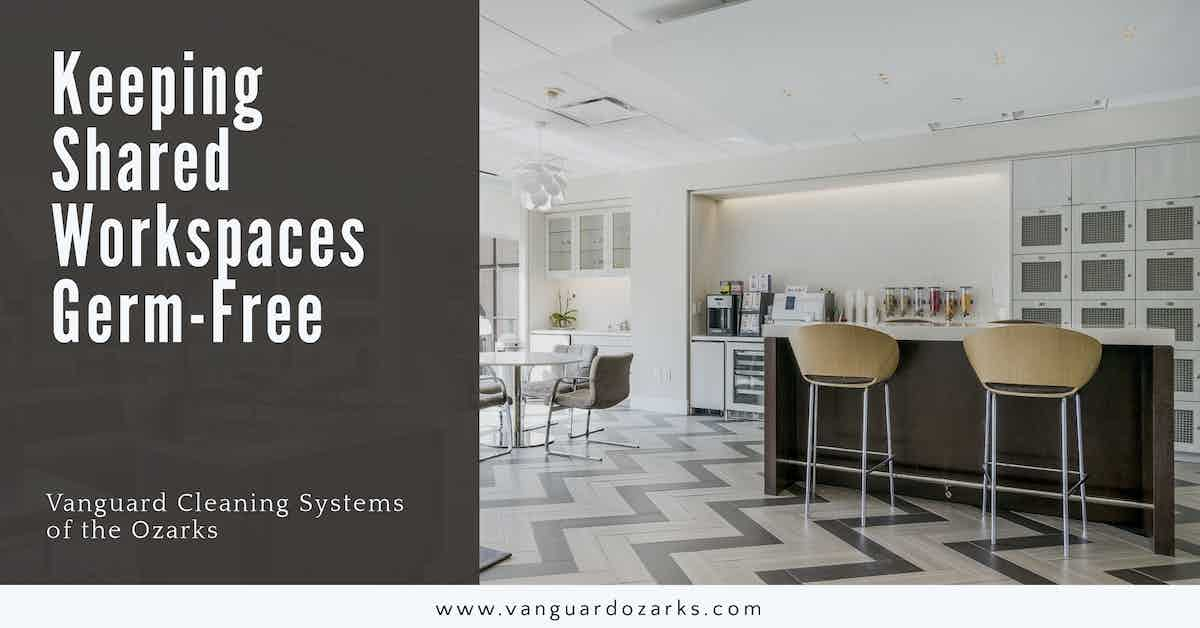A germ-free workplace requires a combination of ongoing enhanced cleaning and disinfection measures paired with occupants assuming ownership of the surface hygiene in their individual and shared workspaces.

Germs in Shared Workspaces
Shared office workspaces contribute to improved workforce productivity and creativity.
However, the benefits of increased collaboration and cooperation come with a cost--an increase in exposure to other office workers.
While that may not seem like an issue--research has shown that even minor lapses in personal hygiene can send illness spreading through a workplace at a rapid pace.
A study conducted by University of Arizona researchers found that a single contagious facility occupant can contaminate roughly half the commonly touched surfaces and other occupants in four hours through person-to-person or surface contact.
Additionally, these germs can survive for days, sometimes weeks, without proper intervention.
For example, according to the results of a recent study that assessed the survival rate and transmissibility of common pathogens;
Both influenza A and B viruses survived for 24-48 hr on hard, nonporous surfaces such as stainless steel and plastic but survived for less than 8-12 hr on cloth, paper, and tissues.
Measurable quantities of influenza A virus were transferred from stainless steel surfaces to hands for 24 hr and from tissues to hands for up to 15 min.
Virus survived on hands for up to 5 min after transfer from the environmental surfaces.
These observations suggest that the transmission of virus from donors who are shedding large amounts could occur for 2-8 hr via stainless steel surfaces and for a few minutes via paper tissues.
Thus, under conditions of heavy environmental contamination, the transmission of influenza virus via fomites may be possible.
Shared Workspace Germ Hotspots
There are several areas in most buildings that typically house a disturbing number of germs and bacteria, including:
- Printers.
- Mice, keyboards, phones, and touchscreens.
- Water coolers.
- Elevator buttons.
- Refrigerators, and;
- Coffee pots and mugs.
The two most contaminated spaces are typically the restrooms and employee desks, especially if the desk is shared with other co-workers.
According to the European Cleaning Journal;
Washrooms have the highest footfall in most buildings, and so are natural hubs for germs.
While you’d hope people would wash their hands, it’s not always the case.
As a result, germs can be transferred quickly from one surface to the next in any office – especially as hands are responsible for the spread of 80 percent of infectious diseases.
Further, according to Coworker;
Office workers spend more time at their desks than anywhere else, so it’ll probably come as no surprise that desks often have the most germs.
Researchers have even found that desks can contain 400 times more germs than toilet seats!
Of the items on your shared desk, your phone is often the biggest culprit for contamination, featuring over 25,000 organisms per square inch on its surface.
Make sure to wipe it regularly with antibacterial wipes, focusing especially on the ear, mouthpiece, and keypad areas.
Shared Workspace Germ Intervention
Shared workspaces are shared responsibilities, but occupants need the tools to address daily health and hygiene challenges safely and effectively.
Occupants should be provided with:
- Hand sanitizer.
- Microfiber towels.
- Disinfectant wipes, and;
- Tissue paper.
Hotspots should be wiped down at the beginning and end of every workday.
Additional guidelines that will increase the efficacy of daily facility cleaning programs include:
- Asking occupants to clear their desks of unnecessary items before leaving to ensure custodial workers have unrestricted access to workspace surfaces.
- Advising occupants not to place their purses, briefcases, backpacks, or laptop bags on the desk, especially if it was recently on the floor.
- Requesting occupants throw away all garbage in the appropriate container, and;
- Advising occupants of the health and hygiene benefits of cleaning their cellphones, laptops, pens, and tablets daily, especially if the equipment is shared.
References & Resources
- Germs Spread Fast at Work, Study Finds
- Leave No Trace: Shared Responsibility in a Shared Space
- Fighting Germs As Desk Swapping Becomes More Common
Takeaway
Ensuring occupant safety requires a commitment to high-outcome environmental sanitation standards, meaning the office should be cleaned daily by trained staff using high-quality products and modern methods.
Unfortunately, onboarding the requisite labor and material resources to ensure consistent high-quality outcomes may prove cost-prohibitive for many organizations.
Outsourcing is a proven method for onboarding skilled service providers equipped with the latest training, processes, and technologies for a fraction of the price of maintaining a comparable service in-house.
Contact us today and discover why Vanguard Cleaning Systems® is the Standard of Clean® for businesses throughout Northwest Arkansas, Missouri, and Oklahoma.
In Oklahoma, dial 918-960-4450
In Arkansas, dial 479-717-2410
In Missouri, dial 417-812-9777

